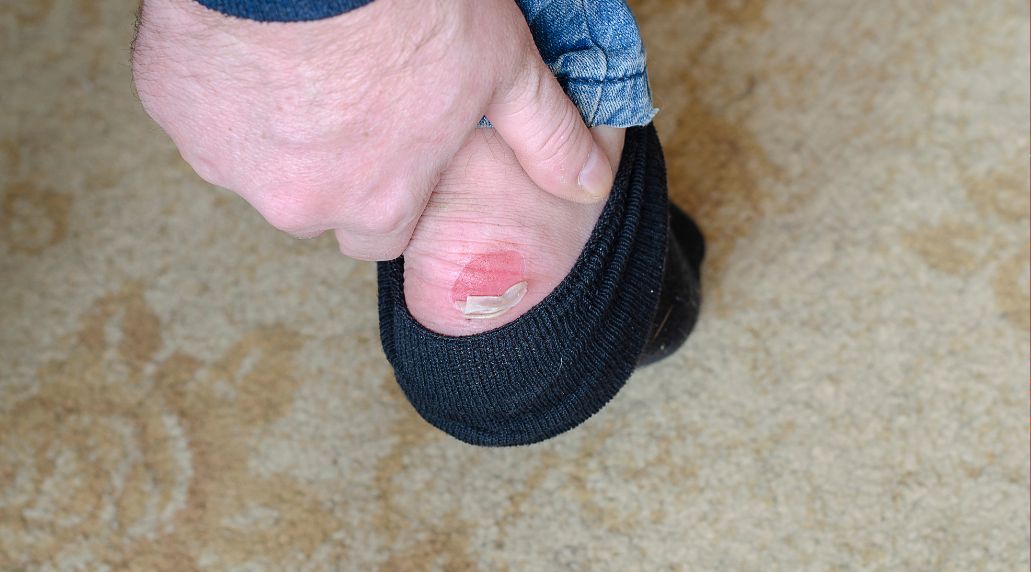If you are an active person and enjoy walking, running or playing sports, it is likely that you have ever suffered from chafing or blisters on your feet. These can be painful and annoying, but there are several ways to treat and prevent them. In this article, we will give you some tips on how to cure foot chafing and how to prevent it in the future.
What are foot blisters and how to cure them?
Foot blisters are a skin injury that occurs when the skin is repeatedly rubbed against a hard or rough surface. The blister is a fluid-filled sac that forms as a natural protection of the skin. If left intact, the blister will dry out and heal on its own within a few days. However, if it bursts, it may be more painful and take longer to heal.
If you have a blister on your feet, it is important to treat it properly to avoid infection. To do this, follow the following steps:
- Wash your feet with mild soap and water and dry them well.
- Use a sterile needle to prick the blister at its base. Do not pop it, as this can expose the skin to bacteria and cause an infection.
- Gently drain the fluid with a sterile cotton pad and leave the skin intact.
- Clean the blister with mild soap and water and apply an antibiotic cream.
- Cover the blister with sterile gauze and tape to prevent infection.
It is important that you change the gauze and tape daily and keep the wound clean and dry. If the blister becomes infected or does not improve after several days, see your doctor.
How to cure a chafed foot?
A foot rash is a skin irritation caused by repeated rubbing against a hard or rough surface. To heal a chafing, follow these steps:
- Wash your feet with mild soap and water and dry them well.
- Apply an anti-chafing cream or an anti-friction stick, such as Compeed Stick Anti Friction, to the affected area.
- If the skin is irritated and raw, apply a healing cream or an antibiotic cream.
- Cover the affected area with sterile gauze and tape to prevent further irritation.
It is important that you avoid wearing shoes or socks that cause friction in the affected area. If the rash does not improve after several days or if it worsens, see your doctor.
- How to prevent chafing on the feet?
The best way to prevent chafing on your feet is to wear comfortable footwear appropriate for the activity you are going to do. Additionally, there are some tips that can help prevent foot chafing:
- Choosing appropriate footwear: Choose footwear that fits your foot well, without being too tight or too loose. It is also important that the footwear is appropriate for the activity to be carried out.
- Wear appropriate socks: Socks should be made of a material that allows breathability, such as cotton or synthetic fibers.
- Moisturize your feet: Keeping your feet hydrated helps prevent the formation of chafing. Apply moisturizer after washing your feet and make sure it is absorbed well before putting on socks or shoes.
- Use anti-chafing products: There are specific products to prevent chaffing on your feet, such as Compeed's anti-chafing sticks, which can be applied to areas prone to chafing to reduce friction.
- Avoid walking with wet feet: Wet feet are more prone to chafing, so it is important to dry your feet well after washing them or after an activity that has caused them to sweat.
- How to cure chafed feet?
If, despite taking preventive measures, a chafing has occurred on your feet, it is important to treat it correctly to prevent it from worsening and becoming infected. Below are the steps to follow to cure chafed feet:
- Clean the affected area: Wash the affected area with mild soap and water to remove dirt and bacteria.
- Apply an antibiotic cream: If the chafing has caused a blister or left the skin raw, it is advisable to apply an antibiotic cream to prevent infection. It is also important to cover the chafing with a sterile dressing or gauze to protect it from friction and rubbing.
- Rest the affected area: If the chafing is painful, it is advisable to rest the affected area and avoid activities that could make it worse.
- Elevate the affected area: If the chafing is on the bottom of the foot, elevate the foot for a few minutes several times a day to reduce inflammation.
- Treat blisters: If rubbing has caused a blister, don't pop it. Instead, protect the blister with a sterile dressing or gauze and let it heal on its own. If the blister breaks accidentally, wash the area with mild soap and water, apply an antibiotic cream, and cover the area with a sterile dressing or gauze.
- Home remedies to cure chafed feet
If you don't have immediate access to the products recommended above, you can try some home remedies to relieve chafed feet. Below, we leave you some that can be effective:
- Aloe vera: Applying aloe vera gel to the affected area can help reduce inflammation and accelerate skin healing.
- Apple cider vinegar: Apple cider vinegar has anti-inflammatory and antibacterial properties that can help reduce irritation and prevent infection. To use it, mix equal parts of water and apple cider vinegar and apply it to the affected area with a cotton ball.
- Green tea: The anti-inflammatory and antioxidant properties of green tea can help relieve irritation and reduce pain. Prepare a green tea infusion and let it cool before applying it to the affected area with a cotton ball.
- Coconut Oil: Coconut oil is an excellent natural moisturizer that can help relieve irritation and prevent infection. Apply a small amount to the affected area and allow it to absorb into the skin.
- When should you go to the doctor?
In most cases, foot chafing heals on its own with proper care at home. However, if the rash is deep, infected, or if the skin is red, swollen, and hot to the touch, you should see a doctor.
For large blisters, especially if they are filled with pus or cloudy fluid, medical attention should also be sought. In these cases, it is important that the doctor examine it to determine if the application of an antibiotic cream or some other treatment is necessary.
In conclusion, chafed feet are a common problem that can be largely prevented with proper care. If you encounter a chafing, be sure to treat it properly to avoid further complications.


